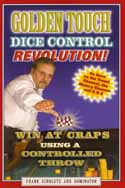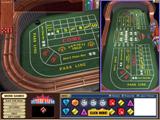
Golden Touch Dice Control Revolution! How to Win at Craps Using a Controlled Dice Throw!
Craps: Is Regression Betting a Good Way to Play?
Is regression betting a good way to wager? Actually, yes, it is, well, kind of.
A typical regression play, called the $110 one-hit-and-down, would go like this:
The shooter has established his point. Frank Scoblete is the one of the most popular gaming authors in America. He has released sixteen books, three audiotapes, three videotapes, and his own imprint, the Scoblete Get-the-Edge Guides. Frank's website is www.goldentouchcraps.com You place $110 inside; that’s $25 on the 5 and 9, $30 on the 6 and 8. The shooter has 18 ways to hit these four numbers. If he does, the payoff is $35 on the first hit. Once that hit takes place, you lower your bet to $22 across, securing a profit of $13. Now, the rest of this shooter’s roll is pure profit.
Frank Scoblete is the one of the most popular gaming authors in America. He has released sixteen books, three audiotapes, three videotapes, and his own imprint, the Scoblete Get-the-Edge Guides. Frank's website is www.goldentouchcraps.com You place $110 inside; that’s $25 on the 5 and 9, $30 on the 6 and 8. The shooter has 18 ways to hit these four numbers. If he does, the payoff is $35 on the first hit. Once that hit takes place, you lower your bet to $22 across, securing a profit of $13. Now, the rest of this shooter’s roll is pure profit.
The thinking here is that the player has a 50-percent chance of winning this wager on any given roll as there are 36 possible combinations of which the ‘one-hit-and-down’ bettor has 18 of them favoring him. How long would you leave your $110 at risk? Some players would leave it up until it hits or loses to the 7. Others will give themselves a few shots at it before pulling it back.
In a random game of craps, where the 7 is always a 1 in 6 probability, the house edge is a fixed mark, in the case of placing the ‘inside numbers’ of 5, 6, 8, and 9, that mark is about 2.6 percent. What that means is that the player making the ‘inside numbers’ bet will lose 2.6 percent of all the money he wagers – in the long run. If on one bet, he has $110 at risk and on other bets, he only has $22 at risk; the house edge is working on some average amount between the two extremes.
Of course, when regression betting is working to perfection and an inside number is hit early and often on shooter after shooter; it is a guaranteed one-roll win per shooter.
But when the 7 shows before an inside number, the loss is brutal. Once you’ve lost the $110, if you continue to regress on future shooters as you planned it will take approximately 10 shooters in a row to get past that first hit or one shooter to have a monster roll as you collect on your $22 across in $7 increments. Yeow!
How often will you be wiped off the board before an inside number can be hit?
You’ll win 18 times on your numbers, lose six times on that abominable 7. That means you’ll win 3 times for a win of $35 + $35 +$35 = $105; then you’ll lose once for a loss of $110. You’re $5 in the hole. You’ll have the same effects once you regress down to $22 across. You’ll win $7 + $7 +$7 = $21 but you’ll lose the fourth bet for $22.
While regression betting does reduce the house’s take on your money, it does so because you are betting less, not because you have come up with a way to beat the game or reduce the house edge.
Still, 75 percent of the time using the above regression will result in being ahead of the game on a particular shooter. You might even consider changing your attack to stop going up on that $110 inside and instead continue with $22 inside on subsequent shooters.
Not all regressions are as drastic as the $110 and down that I’ve just explained.
You could, for example, put $44 inside and when it hits once, go to a six dollar 6 and 8. A single hit on $44 inside would see you win $14. Now with just $12 at risk on the 6 and 8, you are ahead $2. Again, such a betting strategy cannot turn a negative into a positive; the house has its damnable edge on each and every bet you make in a random game betting those inside numbers.
Do I enjoy regression betting? No, I do not. As a general rule, once I’ve gone with a shooter, I’m usually on that shooter come hell or high water. I prefer to take the risk to go for the bigger win by keeping my initial bets at their initial levels. But in math terms, against random rollers, I am giving the house a better whack at me than had I regressed.
Regression betting has its advocates and its opponents. Some people swear by it; some swear at it. In the final analysis, against random shooters, you’re betting less; against controlled shooters, you might be getting in for some significant hits before coming down. If you like this as an idea, try it out on your next casino trip and see if you like it as much in reality.

